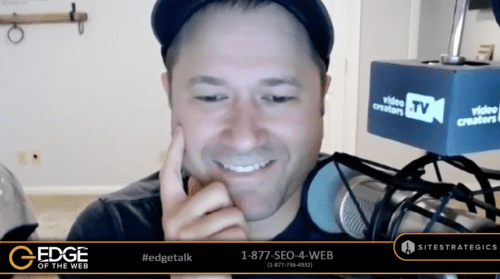Our special guest for episode 367 of the award-winning EDGE of the Web podcast was guest Tim Schmoyer, Founder and CEO of Video Creators. Host Erin Sparks spoke with Tim about the common pitfalls many companies experience when they try to get into online video marketing. Here’s what we learned:
Tim Schmoyer: His Background and Experience

It was back in 2006 when Tim was in graduate school and wanted to introduce his girlfriend to his family located across the country, so he uploaded video clips of he and his girlfriend hanging out together to YouTube. He was very surprised to realize that complete strangers were also watching those videos. That set him on the path of really trying to figure out how YouTube could be purposefully leveraged for greater visibility. Fast forward to 2011 and Tim became one of the first people to train other YouTube creators on how to use it to their advantage. His company, Video Creators, has since been featured on Fox, the BBC, Forbes, and even YouTube itself. Thanks to Video Creators, clients have collectively racked up more than 17 billion views and more than 70 million subscribers. Among his clients have been brands such as HBO, Warner Brothers, Disney, eBay, Budweiser, and many others. Tim is also a regular at related industry events such as YouTube Space New York, VidCon, Content Marketing World, VidSummit, Video Marketing World, and many others too numerous to mention. Whew!
Expectations and Reality: The Disconnect
Tim worked with one brand that literally poured hundreds of thousands of dollars into producing and posting weekly YouTube videos. Seven full-time staff working on it, professional-grade studios, filming with the absolute latest 8K camera technology, a paid actress to bring their scripts to life, and so on. This brand approached Tim after a year with this question: How is that we’ve spent all this money on producing top-quality video content consistently each week for a year and our top video has only twenty-four (yes, that was 24) views, but some guy in his basement with a webcam can get millions of views?” In fact, A lot of the companies Tim works with are like that. They’re making a go of it but just not getting the results they were expecting.
Another common scenario is that companies who know television think they know online video as well, but those are two very different environments with vastly different user experiences and user expectations. There is not a simple, direct correlation between them. Getting clients to understand these differences and how they relate to marketing can be difficult or easy depending on how teachable and humble they are, which can vary widely. The best situation is when the client comes to you because they see it’s not working, and they want to understand how to make it work, even if its painful.
The Number-One Mistake Companies Make
Although the kind of support and strategies Time provides to clients is highly customized to the client’s unique context and needs, there are some common pitfalls many companies fall into when they make the attempt at online video before eventually finding their way to Tim. And the biggest one of all is Not Knowing Your Audience. Seems obvious, right? And yet so many companies who try online video seem to just completely forget this.
Part of the problem is they tend to look at the “who’s already here” data when what they should be asking is who do they want to attract. Build a strategy for the audience you really want. And by “audience” Tim doesn’t mean demographics. What he means is what problem is the person trying to solve and how clearly can they see that you have the solution.
When you truly understand your audience, then your content will resonate deeply with them. Even better, and this is the beauty of YouTube over other social media channels, when YouTube the platform understands the type of person who resonates with your content, it will automatically put your content in front of the right people at the right time, like magic! That’s when you can experience exponential YouTube channel growth.
The Number-Two Mistake Companies Make
The other big mistake companies make is not being clear about their value proposition or brand value. How quickly can someone pick up on the value you’re trying to deliver to them? And this is tricky when it’s a social media platform and people are just stumbling across you and have no prior knowledge of you whatsoever. But they saw something, whether it’s a thumbnail, a title, or whatever, that looked like it would have value for them.
What’s tricky is that if you don’t capture that initial attention by very quickly reinforcing the value you’re bringing, they’ll leave as quickly as they came. How quickly can your brand make sense to people? You have all of 3-5 seconds to do this. It takes a lot of hard work to really dial this in so that a person immediately feels like it’s exactly what they need?
Many companies know they need to have some kind of branded intro to a video, but they make it way too long and it just kills viewership. The maximum brand intro is five seconds. Three seconds is even better. Tim’s on Video Creators brand into is two-and-a-half seconds. You hit it, they get it, and then you present the longer content of the video in question.
The Number-Three Mistake Companies Make
A third really important thing is failing to adequately define the “why” of your brand so clearly and meaningfully that people can grasp it quickly. So the big-picture “why” goes way beyond the basics of what you do. One way to get at how to frame it is to define why you love your job. Say you work for a Disney theme park. You might be doing a very mundane task at Disney, but you love your job because the big picture is that Disney brings families together. Other examples: It’s not about “interior design” per se, it’s about creating spaces where people feel like they belong; it’s not about the debt consolidation software you sell, it’s about giving people hope and the freedom of a fresh start to get back on track; and on and on go similar examples. And again, you have very little time to drive that home right out of the gate so they will resonate and keep watching and then become loyal fans. That level of connection on shared beliefs is so much more fruitful than any other level below it. If you want people to stand for you, you have to stand up for something. That’s what will click. It’s not about the utility you bring, it’s what you stand for.
Understand Primal Branding
The challenge seems daunting to be sure. How in the world can you do everything you need to do around hooking people in with shared beliefs and brand value and all of that in space of a few seconds so they’ll watch the rest of your video?
Tim noted that could be a very long conversation, but he referenced a book called Primal Branding by Patrick Hanlon (no endorsement deal there, it’s just a really good book). He analyzed a bunch of top brands known for having developed cult-like audiences with an eye on identifying what it was they did to make it easy for people to fall in love with them. Hanlon came up with seven key elements he calls the “primal code,” and if you look at the YouTube channels that are just killing it, the align with those key elements. Here they are in summary:
- Creation Story: The backstory of your brand’s origins.
- Creed: What does the company believe?
- Icons: What are the visuals that go with the brand?
- Rituals: What are the repeated interactions people grow to love with the brand.
- Secret Words: Special language and phrases that only your audience knows and understands. Insiders know this secret brand language, and outsiders don’t.
- Nonbelievers: The brand’s haters actually have an integral role to play in building and solidifying your community.
- Leader: Who is the person who embodies this primal code for this brand.
Those are the kinds of things you have to start integrating into your content for people to get the signals they need in order to fall in love with your brand and follow everything you do.
The YouTube Algorithm
The best place to start is to understand what YouTube is looking for, which will in turn inform how you craft your content to perform well in Google’s YouTube, Search, and Discovery systems. There are lots of things YouTube looks for, but here are the big three:
- How much time do people spend watching this video? They call it “watch time” and it is just the total accumulated amount of time people spend watching this particular video. The higher the total watch time, the more valuable Google deems that video. How
- How much does the video contribute to a person’s overall YouTube session? So if there’s a link to a website in the informational section of the video and people click on it and it takes them away from YouTube, that’s not good because it’s interrupting the overall YouTube session. YouTube wants to promote the videos that keep people on YouTube for the longest time possible. And this will trump out watch time because as a business YouTube wants to keep people on its platform, engaging with its content, and therefore seeing more ads because that’s how they monetize the platform.
- How much does this video contribute to bringing people back to YouTube later? So a video that gives people a good experience and makes them want to come back to YouTube for more content is going to be more heavily surfaced.
Those are the big three, and you’ll notice that none of them have to do with keywords, or metadata, or any of those “standard” SEO things because people just abuse it and YouTube can’t trust users’ metadata. Yes, optimize your metadata, but don’t optimize it for SEO bots, optimize it for people and for the big three. Do that and all will be well. Also, the “keep people on the platform” can seem at odds with a business objective of getting people to your website to convert them into sales. Yes, it can make business sense to tempt people off YouTube and to your website, but it doesn’t make sense if the primary objective is to have a discoverable video. And here’s where another mistake comes in that marketers make. For some reason when it comes to online videos, marketers seem to think any given video has to accomplish at least a half-dozen different primary objectives, which is impossible! In no other marketing context is a single asset expected to accomplish everything. Your website has multiple pages, and each page is crafted with a particular goal or objective in mind, not ALL your marketing goals and objectives.
Think of a YouTube channel in the same way, such that each individual video is going to have its primary goal to accomplish. Not all the goals you have. And the ONE goal for each video is what drives all the little elements and aspects of that content. Three “buckets” of video types: 1) “discovery” video’s only object is to get the viewer to seamlessly go into another video. 2) “community” video where the only goal is to get the person to engage with the brand in some way, like making a comment, etc. 3) “sales” videos, but it’s not a commercial, it still delivers your brand value but has a different call-to-action (CTA) that is mor like click the link below, signup, subscribe, register, buy, etc. So the YouTube channel builds a customer journey of discovery, community building, leading to sales. But ONE video can’t do all of those.
When you do it this way, it works! Tim with worked a guy who was producing five videos a week, M-F, but every video ended with a CTA to buy his online course. That meant his was constantly trying to sell to the same people because he wasn’t bringing in enough new people. His revenue at the time was about $20k/month. Tim told him to switch up to two discovery videos and two community videos per week and only one sales video a week each Friday. The client was reluctant to decrease the volume of sales videos thinking it would decrease his revenue. But Tim knew the strategy he proposed would work and the client agreed. The next month both his YouTube channel AND his revenue increased five-fold. Yes, he 5x’d his revenue by producing FEWER sales videos because the new strategy reached all kinds of new people. That’s the power of how getting this right can work.
Connect with Tim Schmoyer and Video Creators
Twitter: @timschmoyer (https://twitter.com/timschmoyer)
Video Labs 8-Week Program: https://videocreators.com/video-labs/
LinkedIn: https://www.linkedin.com/in/timschmoyer/
YouTube: https://www.youtube.com/videocreators
Facebook: @videocreators (https://www.facebook.com/videocreators)
Podcast: https://videocreators.com/podcast
Website: https://videocreators.com
What’s Up with Your Digital Marketing ROI?
Is your digital marketing ROI something you know you should be paying attention to but don’t know where to start? We can help! Begin by getting a baseline with a Site Strategics report examining your SEO, content, social media, and PPC. Visit https://edgeofthewebradio.com/roi to get 30% off a comprehensive review of your digital assets!


